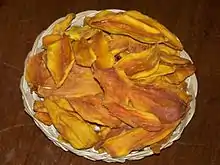Dried mango
Process
Before the drying process begins, the mango that has been sliced will usually have moisture on the surface. Hot air drying is a major method of processing agricultural and sideline products, its principle being that hot air is flowing into the chamber to heat the material and speed up the flow of air so that the water drains away quickly and let the mangoes slices dry. In the drying process, warm air that has little moisture will be used to pick up the moisture on the surface of the sliced mango. As the water on the surface is being evaporated, the water from inside the mango is also being drawn out to the surface to replace the lost moisture. The process of water being drawn out from the center of the material to the surface is called diffusion. Then the moisture will also be taken away by the warm air. As moisture is being drawn out to the surface, moisture on the surface will be less visible until it reached a point where the surface will no longer look wet. The rate of moisture removal will also be slower as time goes on. As moisture is being drained out of the mango, its cellular structure will begin to break down, causing the mango to shrink. At high temperature, moisture can be drawn out too quickly that a thick hard layer is formed in the surface of the mango. The thick layer will trap moisture inside the mango making it really difficult to entirely dehydrate the mango. This phenomenon of developing hard skin-like outer layer is called case-hardening.[1]
Case hardening is the result of a large amount of heat dehydrated production, which hardens the exterior of the fruit or vegetable, making it difficult to avoid moisture crumb. The food dried at a very high temperature, the outer surface will harden, preventing moisture from escaping through the center of the slice. The food shrinks when it dries, so use fine hemp for small fruits. This results in the fruit center remaining moist and then prone to spoilage during storage.
Nutrients
Mangos are a rich source of vitamin-C and pulpy content which the mango has pulp content loss due to excess heat drying due to heat radiation The moisture content get dry off which makes the mango some amount tasteless. The nutritional value also get differ in minimal amount and the fibres present in the fruit also get distorted and the fruit become hard. During the drying process of mango, there are some nutritional values which are still retained and lost. 100 gram of dried mango contains about 314 calories, in which carbohydrates are the main source of calories, followed by protein and fat.[2] Dried mango has 20% daily-value of Vitamin A and notable content of Vitamin B, D, and E. However, most of the vitamin C in the mango is lost during the process of dehydration; it carries only 2% of daily value. Minerals such as calcium, iron, and phosphorus can be found in dried mango.[3]
With additional process of blanching, dried mango can retain the content of its carotenoids and vitamin C.
Storage
While mangos can be stored for around 5 days, dried mangos can be stored for a lot longer depending on a variety of factors, such as the best by date, the drying method, and how the dried mango is stored. Dried Mangos keep fresh in the fridge or in their pantry in tightly closed containers to keep out moisture and other contaminants. Unopened dried mango stored in the pantry can be stored between 6–12 months. If stored in the refrigerator, it can be stored for 1–2 years. When frozen, it can be stored indefinitely. However it is best to check for signs to see whether the fruit has gone bad.[4]
The shelf life of dried mango can be extended by keeping it in a pantry or the refrigerator in a tightly sealed container to keep out moisture and other contaminants.
Freezing dried mango is supposedly able to extend the shelf life indefinitely. But like most foods, after a long period of time, it can break down and develop freezer burn.[4] The freezer time shown is only for the best quality - the dried mango is kept frozen at 0 °F continuously, which will be safe indefinitely.
Expelled ruined dried mangoes for better nature of others. The best way is to look at and smell the dried mangoes: discard anything that has an odor or appearance; If the mold is visible, discard the dried mangoes. Common traits of dried mango going bad are discolouration, hardness, and loss of flavour.[4]
See also
- Mango powder, used as a citrusy seasoning
References
- "A Basic Guide to Drying Fruits and Vegetables" (PDF). iufost.org. 2012. Retrieved 2020-09-08.
- Odom, Erik. "Dried Mango Nutrition Information". Retrieved 9 September 2018.
- "Dried Mangoes". www.driedworld.com. Retrieved 9 September 2018.
- "How Long Does Dried Fruit Last? Shelf Life, Storage, Expiration". Retrieved 9 September 2018.

